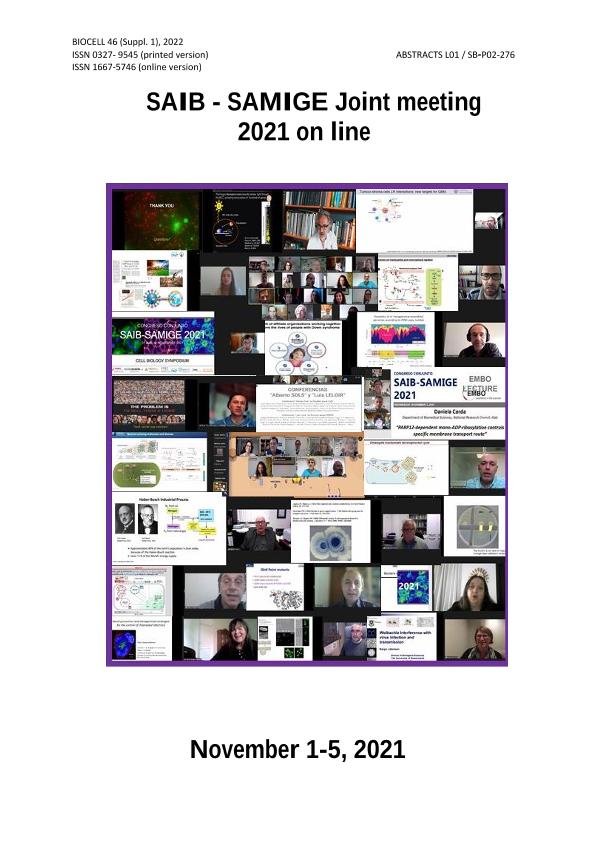Mostrar el registro sencillo del ítem
dc.contributor.author
Centurión, Y.
dc.contributor.author
Alvarez, Hector Manuel

dc.contributor.author
Hernández, Martín Alejandro

dc.date.available
2022-02-23T13:51:05Z
dc.date.issued
2022
dc.identifier.citation
Characterization of two DGAT enzymes in the non-oleaginous Rhodococcus fascians strain F7; LVII Annual Meeting of the Argentine Society for Biochemistry and Molecular Biology Research and XVI Annual Meeting of the Argentinean Society for General Microbiology; Argentina; 2021; 1-4
dc.identifier.issn
0327-9545
dc.identifier.uri
http://hdl.handle.net/11336/152590
dc.description.abstract
Some species of the Rhodococcus genus, such as R. opacus and R. jostii, are able to accumulate triacylglycerols (TAG) up to 60% or more of their cellular dry weight. For this reason, oleaginous rhodococci are promising microbial cell factories for the production of lipids to be used as fuels and oleochemicals. In agree with their oleaginous phenotype, species with the greatest capacity for TAG synthesis have several copies of atf genes coding for potential DGAT enzymes in their genomes. For example, R. jostii RHA1 and R. opacus PD630 contain up to 16 copies of atf genes. This high gene redundancy makes these strains very robust models for TAG accumulation but at the same time, they constitute very complex models to study the individual contribution of DGAT enzymes. In this study, we analyzed the R. fascians F7 genome, a non-oleaginous bacterium able to accumulate significantly TAG only under certain conditions (minimal media with glycerol as the sole carbon source). F7 strain possesses only two atf copies (F7_3568 and F7_4458) coding for possible DGAT enzymes and then, it constitutes a good model to study the DGAT enzymes and their role not only in TAG biosynthesis but also in its cellular physiology. Bioinformatic analysis revealed that F7_3568 possess the typical HHxxxDG catalytic site, whereas in F7_4458 this site is only partially conserved. RT-PCR analysis demonstrate that F7_3568 and F7_4458 genes are induced approximately 2-fold at low nitrogen levels but F7_3568 expression was higher than F7_4458 in both nitrogen rich and nitrogen poor culture media. In order to analyze the contribution of each gene in the physiology and lipid metabolism, we also overexpressed both genes under an inducible thiostrepton promoter. The growth profiles in recombinant strains (F7 pTip-QC2 /F7_3568 and F7 pTip-QC2 /F7_4458) did not show significant differences with control cells either with fructose or glycerol as the sole carbon sources. On the other side, whereas overexpression of F7_3568 gene result an increase of TAG content, no significant changes were observed in the case of F7_4458 gene in comparison with control cells cultivated with same carbon sources. The results obtained in this study suggest that F7 cells possess at least one active DGAT enzyme responsible for TAG biosynthesis. Deciphering the functions of these enzymes is of great importance not only to understand the role of TAG in the physiology and survival of these microorganisms but also as a key target to improve the lipid content in these bacteria for biotechnological purposes.
dc.format
application/pdf
dc.language.iso
eng
dc.publisher
Tech Science Press

dc.rights
info:eu-repo/semantics/openAccess
dc.rights.uri
https://creativecommons.org/licenses/by-nc-sa/2.5/ar/
dc.subject
RHODOCOCCUS FASCIANS
dc.subject
DGAT
dc.subject.classification
Biología Celular, Microbiología

dc.subject.classification
Ciencias Biológicas

dc.subject.classification
CIENCIAS NATURALES Y EXACTAS

dc.title
Characterization of two DGAT enzymes in the non-oleaginous Rhodococcus fascians strain F7
dc.type
info:eu-repo/semantics/publishedVersion
dc.type
info:eu-repo/semantics/conferenceObject
dc.type
info:ar-repo/semantics/documento de conferencia
dc.date.updated
2022-02-17T13:22:35Z
dc.identifier.eissn
1667-5746
dc.journal.number
46
dc.journal.pagination
1-4
dc.journal.pais
Estados Unidos

dc.description.fil
Fil: Centurión, Y.. Universidad Nacional de la Patagonia "San Juan Bosco". Facultad de Ciencias Naturales - Sede Comodoro. Departamento de Bioquímica; Argentina
dc.description.fil
Fil: Alvarez, Hector Manuel. Universidad Nacional de la Patagonia "San Juan Bosco". Instituto de Biociencias de la Patagonia. Consejo Nacional de Investigaciones Científicas y Técnicas. Centro Científico Tecnológico Conicet - Centro Nacional Patagónico. Instituto de Biociencias de la Patagonia; Argentina
dc.description.fil
Fil: Hernández, Martín Alejandro. Universidad Nacional de la Patagonia "San Juan Bosco". Instituto de Biociencias de la Patagonia. Consejo Nacional de Investigaciones Científicas y Técnicas. Centro Científico Tecnológico Conicet - Centro Nacional Patagónico. Instituto de Biociencias de la Patagonia; Argentina
dc.relation.alternativeid
info:eu-repo/semantics/altIdentifier/url/https://www.techscience.com/biocell/v46nSuppl.1
dc.conicet.rol
Autor

dc.conicet.rol
Autor

dc.conicet.rol
Autor

dc.coverage
Internacional
dc.type.subtype
Reunión
dc.description.nombreEvento
LVII Annual Meeting of the Argentine Society for Biochemistry and Molecular Biology Research and XVI Annual Meeting of the Argentinean Society for General Microbiology
dc.date.evento
2021-11-01
dc.description.paisEvento
Argentina

dc.type.publicacion
Journal
dc.description.institucionOrganizadora
Sociedad Argentina de Investigación en Bioquímica y Biología Molecular
dc.description.institucionOrganizadora
Asociación Civil de Microbiología General
dc.source.revista
Biocell

dc.date.eventoHasta
2021-11-05
dc.type
Reunión
Archivos asociados
